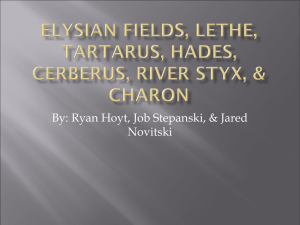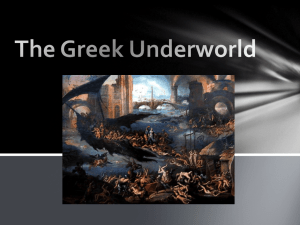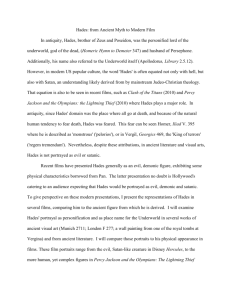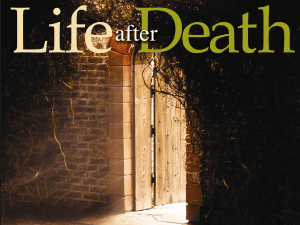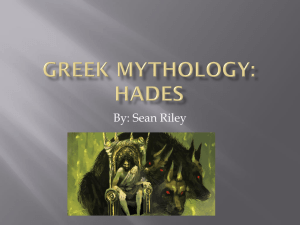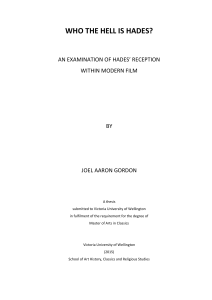Archetype Essay Exemplar
advertisement
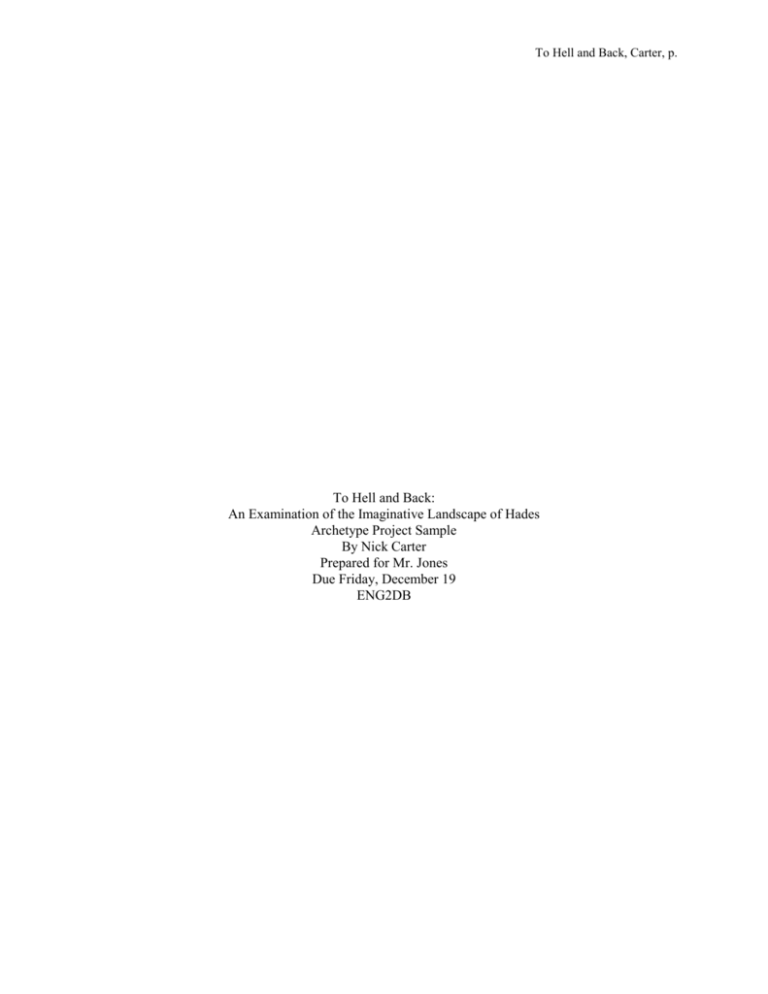
To Hell and Back, Carter, p. To Hell and Back: An Examination of the Imaginative Landscape of Hades Archetype Project Sample By Nick Carter Prepared for Mr. Jones Due Friday, December 19 ENG2DB To Hell and Back, Carter, p. 2 The ancient Greeks did not share the Christian concept of Heaven or Hell but the former did influence the latter. In the Greek imagination, if people demonstrated goodness in this life, they did not go to Heaven as a reward, nor did they travel to Hell to receive punishment. In fact, the Greeks did not regard the existence of Death as an end to existence at all, but as the beginning of a new life in the underworld. In this respect, the ancients identified the subterranean realm of Pluto or Hades, as a gloomy place often difficult to enter and virtually impossible to leave. (Graves, p.139) Even a casual glance at Greek values and attitudes about life and death as revealed in their mythology reveals that they had equivalent notions about death as characterized by the Christian concept of hell. All mortals who died eventually travelled to one of several places in Hades, a gloomy world where the dead resided - gloomy because they knew that life and its joys sensory pleasures no longer existed. Furthermore, scholars like Northrop Frye state that such ancient mythologies reveal a much broader understanding of demonic image patterns which continue to shape our imaginations today. Hades, while not organized in the same hierarchical pattern as suggested in Dante’s Inferno, does nonetheless, function like a real monarchy with its hierarchical chain of command. Thus, an examination of the Greek concept of Hades reveals a landscape which underscores the ancient values of cosmic order, human virtue, and divine punishment. The features of order, purpose and structure most characterize the workings of Hades in the Greek mind. Reminiscent of Frye’s notion of demonic imagery, with its allusions to the Great Chain of Being, all aspects of Hell suggest a hierarchical pattern. The lords entrusted with the care of Hades tended to those lesser beings beneath them, like the newly arrived souls. Each ruling member performed a particular role in the underworld. For example, before actually crossing the river Acheron to Hades, the dead, referred to as “souls or shades” (Graves, p.138), had to appeal to Charon, the boatman, who ferried passengers across to the other side. Direct payment for this voyage determined the order for embarking the passengers. For this reason, Greeks always placed coins in the mouths of the dead during burial. Those shadows that did not receive proper burial were not able to cross the river until Charon saw fit. Even in death, the To Hell and Back, Carter, p. 3 Greeks believed that passage to the dark place was defined by an orderly and civilized set of rules and procedures, like any well-run organization. Once the dead crossed the Acheron, they entered the realm of Hades itself where punishments were meted out according to the severity of the sins performed in mortal life. A large three-headed dog, Cerberus, guarded the gate to Hades, thus ensuring that no one could leave without the approval of its superiors, namely Hades, the Lord of Darkness, and his brother Zeus, the ruler of Olympus. At the point of entry, each soul received a court ruling delivered by the three judges who sat to the right of Lord Hades: Minos, Rhadamanthys, and Aeacus. Souls then stepped onto the scales of Themis, the blindfolded, impartial goddess of judgment, “who bore a...sword to indicate that her decrees would be mercilessly enforced.” (Graves, p.139). The decision granted regarding each sinner’s crime determined which of two roads he or she needed to take, leading to different inner regions of Hades. Again, the landscape of Hades reminded the ancients that death could produce a variety of after-life experiences. Each region, while part of the underworld retained its own unique character with its own unique punishments. In this geography, the great rivers of Hades ensured the logical separation of the damned, as well as the heroic. The river Styx divided others from the hated, the Acheron bound up the woeful, the Lethe held the fraudulent and forgetful, the Phegethon contained the fiery-spirted sinners, and the Cocytus surrounded the greatest of all sinners. In this predicable geography for example, heroic spirits like Achilles and Hector found themselves in the Elysian Fields, where those favoured by the gods retained their bodily form as part of their immortal existence. The other road led to Tartarus, where people disliked by the deities, experienced severe punishment for an eternity. Here one would have found Prometheus, the Titan, whose liver is consumed everyday by a giant vulture, only to have it regenerate for the next day’s excruciating pain. Likewise, Sisyphus, the cruel king of Corinth, and Salmoneus, a king guilty of vanity and selfishness, resided here in Tartarus. Scholar Robert Graves points out, “Many victims renowned on earth for their cruelty found here the just punishment for their sins.” (Graves, p.142) In other words, the stories of Hades catalogue countless crimes, but all are equally unending in their punishments; sinners are To Hell and Back, Carter, p. 4 doomed for an eternity to roll huge rocks, whirling round, or sit in the Chair of Oblivion. Likewise, Dante’s first installment of The Comedy, the Inferno draws most of its imaginative conception from the Greek concept of Tartarus in Hades. His epic story patterns its protagonist’s journey through the underworld as a set of concentric circles, each leading to a different locale characterized by a different series of graduated punishments, the worst being at the centre of Hell. Each circle relates the ever-growing corruption of people’s live in the upper world. In other words, over time the underworld became a highly organized place which helped to define a hierarchy of rewards and punishments. For the ancient Greek mind Conversely, the recurrent motif in many stories of the netherworld define what humans would call virtuous behaviour. For example, Aeneas, the founder of Rome in Virgil’s The Aeneid, is perhaps one of the only mortals in literature who successfully travels through Hades back to the world of men. In his heroic journey he notes that entering the Elysian Fields he sees “the heroes who have fallen in battle.” (Bulfich, p.268) This part of Hades, with its capital located at the palace of Elysium, (Bulfinch, p.273) came to symbolize the place of happiness and goodness, of valour and honour available to human beings. Other stories of Hades pointed out how some clever mortals could even “cheat death” and achieve a second chance at life. For example, the sad story of Orpheus and Eurydice, the faithful husband who comes to Hades to reclaim his deceased wife, remained a favourite among the ancient Greeks because of its poignancy and its lessons about adhering to the rules of the underworld if one even hoped for a second chance. In a moment of forgetfulness after sealing a bargain with Lord Hades, Orpheus looked back to see his faithful wife following him out of Hades; in so doing he broke his promise in the underworld which resulted in the “death” of his wife for a second time. (Bulfinch, p.187) For the Greeks, such stories about Hades helped to define valour and virtue as well as punishment and sin. The dark underworld of Hades, has been, is and continues to occupy a special place in the imagination of Western civilization thanks to the ancient Greeks. While Heaven is clearly not Hades, the influences of one seems to shape our notions of the other. Traditionally, even the To Hell and Back, Carter, p. 5 Roman Catholic Church acknowledges that non-Christians and sinners, enter a place like Hades after death, where they remain until God's time for final judgment of the end of the world. This place is reminiscent of Hades as an interim destination. In the final judgment, God will determine their final destiny: either the kingdom of God [new Heaven and new Earth] or "the lake of fire" [Hell]. (Frye, p.73) Scholar Northrop Frye further stated that Hell evolved into a mixture of Christian and Greek concepts, as a place where “human life (is) created by evil; the world of eternal death...is an abyss or deep nothingness and a world of externally applied torture goes on endlessly in time.” (Frye, p.74) In other words, Hell has become a mirror reflection of Tartarus. As mentioned, sinners suffered terrible punishments here for reasons of hatred, violence, fraud, murder, treason, and incest. These crimes similarly identify all that is good and evil in humanity at the same time. In our everyday lives, these mythological stories of the ancient Greeks reveal a people fascinated with its relationship to the cosmic order, with the nature of punishment and with the principles of virtuous living. In this “world of the dead” the Greeks have laid out a comprehensive series of principles about how to live in this world. References Bulfinch’s Mythology. (1979). Avenel, New Jersey: Crown Publishers, Inc. Cotterell, Arthur ed. (1999). Encyclopedia of World Mythology. London: Parragon Publishing Ltd. Frye, Northrop. (1982). The Great Code. Toronto: Academic Press Canada. Gueber, H.A. (1993). The Myths of Greece and Rome. Toronto: General Publishing Company Ltd. To Hell and Back, Carter, p. 6
